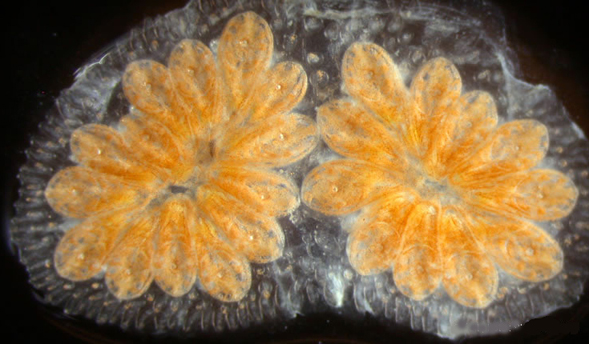Botryllus schlosseri (sea squirt)

Ascidians make up one of the three classes of Urochordata. Urochordates (tunicates), along with cephalochordates and vertebrates, form the phylum Chordata. Botryllus schlosseri is a colonial ascidian tunicate, with individuals (zooids) embedded within a common sheath or tunic. This ascidian species is found in the Mediterranean.
EMBRC expertise:
Access
- Adult colonies are available all year round. Colonies are cultivated on special structures that are immersed in the marina. Fertile colonies are found from May to October in the natural environment.
- Colonies are also maintained in the laboratory but are clones, thus genetically identical, whereas natural colonies grown outdoors can be chimeras.
Available tools
- The life cycle is rapid, with the swimming larvae (“tadpoles”) metamorphosing into oozooids 24 h after hatching. Oozooids produce colonies via asexual budding, generating genetically identical individuals (zooids).
- Colonies can be maintained for several months.
Scientific advantages of this model organism
- Tunicates hold a key evolutionary position because they are considered to be the invertebrates that are the most closely related to vertebrates. Their genome has not undergone total duplication, facilitating functional gene analyses due to the near absence of redundancy.
- Like all species of Botryllidae, Botryllus schlosseri can form and regenerate a zooid through three distinct mechanisms: sexual reproduction during which a fertilised egg becomes a pelagic larva that metamorphoses into a zooid; asexual reproduction with budding (blastogenesis); and; in certain conditions, an adult zooid can be produced by regeneration from the vascular system and blood cells (vascular budding).
- Colonial tunicates are the only chordates that can reproduce both sexually and asexually.
- They are also an excellent study model in immunology: the colonies are irrigated by vascular networks studded with ampullae that — when they come into contact — can cause histocompatibility reactions. Botryllus schlosseri is a good in vivo study model for studying angiogenesis mechanisms and testing anti-cancer therapies.
- These tunicates are also good models for studying stem cell biology and regeneration.
- They can also be used for testing the biocidal activity of compounds.
Available genetic resources
A dozen clones of different genotypes are maintained.
Databases
The genome has been sequenced, revealing 580 Mb organised into 16 chromosomes.
Much information is available on the following sites:
-
Observatoire océanologique de Villefranche - UPMC, CNRS
-
LBDV





